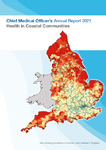Analysis of Coastal health outcomes.
| dc.contributor.author | Asthana, Sheena | |
| dc.contributor.author | Gibson, A | |
| dc.contributor.editor | Whitty C | |
| dc.contributor.editor | Loveless B | |
| dc.date.accessioned | 2021-08-10T10:36:07Z | |
| dc.date.available | 2021-08-10T10:36:07Z | |
| dc.date.issued | 2021-07-21 | |
| dc.identifier.other | 3 | |
| dc.identifier.uri | http://hdl.handle.net/10026.1/17546 | |
| dc.description.abstract |
There has been relatively little research focusing on health and health care in coastal communities. The following chapter is an exploratory analysis comparing coastal and non-coastal areas using Quality Outcome Framework (QOF) data. The key findings of this chapter suggest that: • There is a higher burden of disease and health risk factors in coastal areas, including heart disease, diabetes, cancer, mental health and Chronic Obstructive Pulmonary Disease (COPD). • This difference is partly explained by age and deprivation. However, even after adjusting for these factors (and others including ethnicity), there remains a ‘coastal excess’ in the prevalence of disease and risk factors. • There is some evidence of a health service deficit in terms of recorded service standards, cancers indicators and emergency admissions. The cause of this is unclear. • Standardised Mortality Ratios (SMR) for a range of conditions, including preventable mortality, are significantly higher in coastal areas compared with non-coastal. • Life expectancy (LE), healthy life expectancy (HLE) and disability free life expectancy (DFLE) are all, on average, significantly lower in coastal areas for both males and females. • Lower participation in higher education and higher rates of hospital admissions due to health-risking behaviour by children and young people may point to a degree of socio-psychological as well as economic dislocation in coastal communities. • There is a lack of available small area data for detailed analysis of the health of local communities, both on and beyond the coastal fringe. | |
| dc.format.extent | 189-208 | |
| dc.language.iso | en | |
| dc.publisher | Department of Health and Social Care | |
| dc.relation.ispartof | Chief Medical Officer Annual Report, 2021: Health in Coastal Communities | |
| dc.title | Analysis of Coastal health outcomes. | |
| dc.type | chapter | |
| plymouth.publisher-url | https://assets.publishing.service.gov.uk/government/uploads/system/uploads/attachment_data/file/1004527/cmo-annual_report-2021-health-in-coastal-communities.pdf | |
| plymouth.organisational-group | /Plymouth | |
| plymouth.organisational-group | /Plymouth/Faculty of Health | |
| plymouth.organisational-group | /Plymouth/REF 2021 Researchers by UoA | |
| plymouth.organisational-group | /Plymouth/REF 2021 Researchers by UoA/UoA20 Social Work and Social Policy | |
| plymouth.organisational-group | /Plymouth/Research Groups | |
| plymouth.organisational-group | /Plymouth/Research Groups/Institute of Health and Community | |
| plymouth.organisational-group | /Plymouth/Users by role | |
| plymouth.organisational-group | /Plymouth/Users by role/Academics | |
| dc.publisher.place | London | |
| dc.rights.embargoperiod | Not known | |
| rioxxterms.licenseref.uri | http://www.rioxx.net/licenses/all-rights-reserved | |
| rioxxterms.type | Book chapter |


